Pheidole senex
| Pheidole senex | |
|---|---|

| |
| Scientific classification | |
| Kingdom: | Animalia |
| Phylum: | Arthropoda |
| Class: | Insecta |
| Order: | Hymenoptera |
| Family: | Formicidae |
| Subfamily: | Myrmicinae |
| Tribe: | Attini |
| Genus: | Pheidole |
| Species: | P. senex |
| Binomial name | |
| Pheidole senex Gregg, 1952 | |
| Synonyms | |
| |
Gregg (1963) reports P. senex from Campo, Colorado, in short grass prairie nesting in clay under rocks at 1300 m. Cole recorded it in New Mexico from 2000 to 2700 m. At Springerville, Arizona, I found a colony under a rock in grassy desert. In the Texas Panhandle, Moody and Francke (1982) found two colonies, one beneath a stone and the other in open soil. (Wilson 2003)
Identification
The major of this species can be recognized by the very elongate, sharp lateral connules on the sides of the postpetiole. The anterior half of the head is covered with parallel rugae, the tops of the posterior lateral lobes are covered with fine rugae, the region between the sculptured areas is predominantly smooth and shining. Most surfaces of the minor worker are sculptured: the head has a mixture of parallel striae and punctures, and the entire mesosoma is punctate (usually part of the dorsum of the pronotum, and side of the pronotum are partially smooth and glossy).
Also see the description in the nomenclature section.
Keys including this Species
Distribution
West-central Arizona through New Mexico to the Texas Panhandle and southern Colorado; apparently rare. (Wilson 2003)
Latitudinal Distribution Pattern
Latitudinal Range: 38.795666° to 19.666594°.
| North Temperate |
North Subtropical |
Tropical | South Subtropical |
South Temperate |
- Source: AntMaps
Distribution based on Regional Taxon Lists
Nearctic Region: United States (type locality).
Neotropical Region: Mexico.
Distribution based on AntMaps
Distribution based on AntWeb specimens
Check data from AntWeb
Countries Occupied
| Number of countries occupied by this species based on AntWiki Regional Taxon Lists. In general, fewer countries occupied indicates a narrower range, while more countries indicates a more widespread species. |

|
Estimated Abundance
| Relative abundance based on number of AntMaps records per species (this species within the purple bar). Fewer records (to the left) indicates a less abundant/encountered species while more records (to the right) indicates more abundant/encountered species. |

|
Habitat
Grasslands, pinyon-juniper, pine forests.
Biology
This species has been found nesting under stones and cow manure. Brood was found in nests in April. (Mackay and Mackay 2002)
Castes
Minor Worker
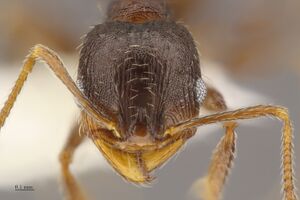   
| |
| Worker (minor). . | Owned by Museum of Comparative Zoology. |
 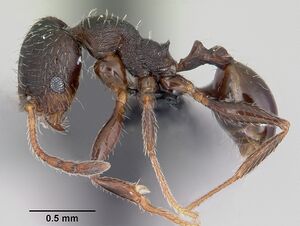 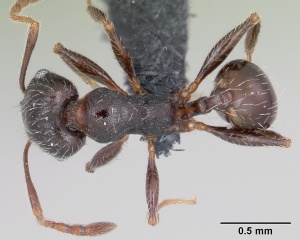 
| |
| Worker (minor). . | Owned by Museum of Comparative Zoology. |
Major Worker
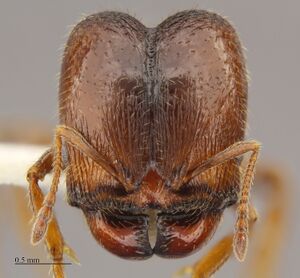 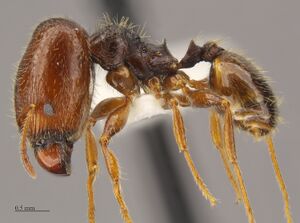  
| |
| Worker (major). . | Owned by Museum of Comparative Zoology. |
Nomenclature
The following information is derived from Barry Bolton's Online Catalogue of the Ants of the World.
- anfracta. Pheidole pilifera subsp. anfracta Cole, 1952c: 278 (s.w.) U.S.A. Junior synonym of senex: Cole, 1953e: 298; Gregg, 1959: 30.
- senex. Pheidole senex Gregg, 1952a: 1 (s.w.) U.S.A. Senior synonym of anfracta: Cole, 1953e: 298; Gregg, 1959: 30. See also: Wilson, 2003: 596.
Unless otherwise noted the text for the remainder of this section is reported from the publication that includes the original description.
Description
From Wilson (2003): DIAGNOSIS A member of the “pilifera complex” of the larger pilifera group, comprising Pheidole calens, Pheidole californica, Pheidole carrolli, Pheidole cavigenis, Pheidole clementensis, Pheidole creightoni, Pheidole hoplitica, Pheidole littoralis, Pheidole micula, Pheidole pilifera, Pheidole polymorpha, Pheidole rugulosa, Pheidole senex, Pheidole soritis, Pheidole tepicana and Pheidole torosa, which complex is distinguished by the following traits. Major: dorsal head surface extensively sculptured; occipital lobes transversely rugulose (or, in carrolli smooth, in littoralis foveate, and in micula and soritis carinulate), postpetiole from above diamond-shaped, trapezoidal, or spinose. Minor: eye medium-sized to large.
P. senex is distinguished within the complex by the following combination of traits.
Major: large; mesonotal convexity subangulate in dorsal-oblique view, and descends steeply to metathorax in side view; petiolar node tapers to a point in side view; postpetiole from above spinose; sides of pronotum, mesonotum, and propodeum, longitudinally carinulate; anterior dorsal profile of head flat; cephalic pilosity short and erect.
Minor: entire dorsal surface of head except mid-section of clypeus longitudinally carinulate; all of mesosoma foveolate and opaque.
MEASUREMENTS (mm) Paratype major: HW 1.74, HL 1.86, SL 0.78, EL 0.22, PW 0.82. Paratype minor: HW 0.64, HL 0.66, SL 0.68, EL 0.14, PW 0.40.
COLOR Major and minor: light yellowish to reddish brown.
Figure. Upper: paratype, major. Lower: paratype, minor. Scale bars = 1 mm.
Type Material
COLORADO: 14 km south of Campo, Baca Co., extreme southeastern Colorado, col. Robert E. Gregg., Museum of Comparative Zoology - as reported in Wilson (2003)
Etymology
L senex, old, senior, possibly alluding to rugulose sculpture of head and mesosoma. (Wilson 2003)
References
- Cole, A. C., Jr. 1952. Notes on the Pheidole pilifera (Roger) complex and a description of a new subspecies (Hymenoptera:Formicidae). J. Tenn. Acad. Sci. 27: 278–280.
- Cole, A. C., Jr. 1953g. Studies of New Mexico ants. V. The genus Pheidole with synonymy (Hymenoptera: Formicidae). J. Tenn. Acad. Sci. 28: 297-299 (page 298, Senior synonym of anfracta)
- Gregg, R. E. 1952a. A new ant of the genus Pheidole from Colorado. American Museum Novitates 1557: 1-4 (page 1, soldier, worker described)
- Gregg, R. E. 1963. The Ants of Colorado, With Reference to their Ecology, Taxonomy, and Geographic Distribution. Boulder: U. of Colorado Press, xvi + 792 pp.
- Mackay, W. P. and E. Mackay. 2002. The ants of New Mexico (Hymenoptera: Formicidae). Edwin Mellen Press, Lewiston, NY.
- Moody, J. V., Francke, O. F. 1982. The ants (Hymenoptera, Formicidae) of western Texas, Part 1: Subfamily Myrmicinae. Grad. Stud. Tex. Tech Univ. 27: 1–80.
- Wilson, E. O. 2003. Pheidole in the New World: A dominant, hyperdiverse ant genus. Harvard University Press, Cambridge, MA. (page 596, fig. major, minor described)
References based on Global Ant Biodiversity Informatics
- DuBois M. B. 1985. Distribution of ants in Kansas: subfamilies Ponerinae, Ecitoninae, and Myrmicinae (Hymenoptera: Formicidae). Sociobiology 11: 153-1082
- Field Museum Collection, Chicago, Illinois (C. Moreau)
- Johnson R. Personnal Database. Accessed on February 5th 2014 at http://www.asu.edu/clas/sirgtools/resources.htm
- Mackay W. P. and Mackay, E. E. 2002. The ants of New Mexico (Hymenoptera: Formicidae). Lewiston, New York: Edwin Mellen Press, 400 pp.
- Moody J. V., and O. F. Francke. 1982. The Ants (Hymenoptera, Formicidae) of Western Texas Part 1: Subfamily Myrmicinae. Graduate Studies Texas Tech University 27: 80 pp.
- O'Keefe S. T., J. L. Cook, T. Dudek, D. F. Wunneburger, M. D. Guzman, R. N. Coulson, and S. B. Vinson. 2000. The Distribution of Texas Ants. The Southwestern Entomologist 22: 1-92.
- Vásquez-Bolaños M. 2011. Lista de especies de hormigas (Hymenoptera: Formicidae) para México. Dugesiana 18: 95-133
- Wheeler, G.C. and J. Wheeler. 1985. A checklist of Texas ants. Prairie Naturalist 17:49-64.
- Wilson, E.O. 2003. Pheidole in the New World: A Dominant, Hyperdiverse Genus. Harvard University Press


